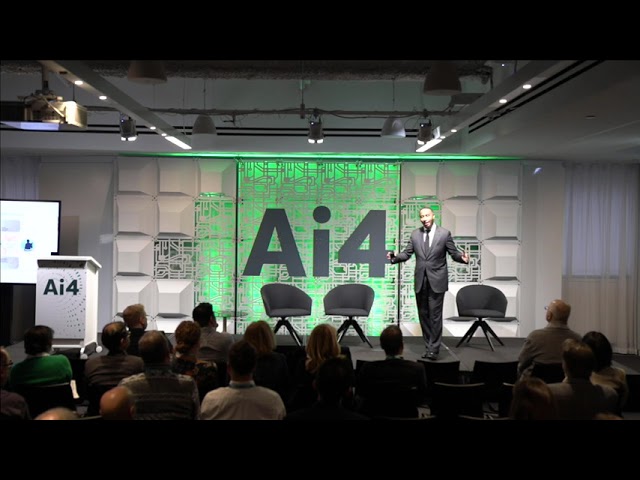Visit our website: http://bit.ly/2GtXaiw
Hassan Tetteh, Health Mission Chief for Warfighter Health at the Joint Artificial Intelligence Center (JAIC), Department of Defense (DoD)
Abstract:
An Artificial Intelligence (AI) revolution is not coming; the revolution is already here. AI is fundamentally changing the landscape of healthcare delivery and many leaders are not prepared. A new paradigm of health care delivery is on the horizon. Like electricity in the past, AI represents the general-purpose technology (GPT) of our era. With inherent challenges, threats, and opportunities ahead, ‘future-oriented’ strategies should be implemented by healthcare and business leaders that leverage AI to create better, stronger, and more relevant healthcare organizations to care for patients and promote health and wellness in the 21st century and beyond.
Like many other industries, healthcare is undergoing significant change. Five key drivers impact the rapid advance in Artificial Intelligence (AI) technology as it relates to the potential application in healthcare. Computer science’s early limitations in computing power, data sources, and expertise are now mitigated. Today, the difference is the convergence of factors that make the potential for AI more advanced now than in the past.
Five key drivers impact the rapid advance in AI technology:
1. Exponential growth in computer power over the past decades
2. Availability of large datasets for machine learning training
3. Machine learning technique improvement
4. Increased commercial and government investment in AI research
5. Use of electronic health records and digital health information
Collectively, the five drivers of AI technology coupled with the abundance of data stored on patients may help to understand disease at a fundamentally better level to facilitate treatment and therapeutics to help patients more effectively and efficiently. Three learning objectives are highlighted:
Learning Objective 1: Define AI technology platforms, recognize the lexicon of AI terminology, and select the specific AI technologies for practical application within a healthcare organization.
Learning Objective 2: Recognize the risk of not leveraging AI, identify the correct approach to AI, and adopt the essential steps required to achieve transformational change using AI.
Learning Objective 3: Understand the “Do No Harm” principles for responsible AI and machine learning application in healthcare.
Al and The Art of Human Care (Joint Artificial Intelligence Center, Department of Defense with DoD)
November 20, 2019
8 views
2 min read
You may also like
Ai for Healthcare, Northwest Medicine Healthcare AI Forum
Northwestern Medicine Healthcare AI Forum — Feb 9, 2024
3 views
1 min read
Ai for Healthcare, Northwest Medicine Healthcare AI Forum
Northwestern Medicine Healthcare AI Forum — Jan 26, 2024
6 views
1 min read
Ai for Healthcare, Northwest Medicine Healthcare AI Forum
Northwestern Medicine Healthcare AI Forum — Jan 12, 2024
9 views
1 min read
Categories
- About AI
- Adobe
- AI
- AI ADVANTAGE TUTORIALS
- AI Art
- AI conferences
- Ai Engineer
- AI Explained
- Ai for Beginners
- AI for Daily Life
- AI for Developers
- AI for For Startups
- Ai for Healthcare
- AI in Popular Culture
- AI in Real Life by the BBC
- AI News
- AI Podcasts
- AI Science
- AI Technology
- AI Tools
- AI Use Cases
- Anthropic
- AWS
- ChatGPT Prompting
- Cold Fusion on AI
- Consumer Product Goods (CPG
- Creativity Squared
- Deep Dive into AI
- Dmitry Shapiro
- Eye On AI
- Featured AI Videos
- Foundational Models
- History of AI
- Introduction to AI
- Lex Fridman Podcasts on AI
- Microsoft
- MIT
- Natural Language Processing (NLP
- OpenAI
- Philosophy of AI
- Python
- Responsible AI
- Sequoia Capital AI Ascent
- Skill leap AI
- TED Talks
- The Ai Conference
- Thought Leaders
- University AI
- World Science Festival on AI
All Topics
- About AI255
- Adobe17
- AI135
- AI ADVANTAGE TUTORIALS169
- AI Art45
- AI conferences465
- Ai Engineer38
- AI Explained73
- Ai for Beginners23
- AI For Business15
- AI for Daily Life95
- AI for Developers118
- Ai for Education122
- AI for Family40
- AI for Fintech151
- AI for For Startups38
- Ai for Good28
- Ai for Healthcare113
- Ai for Kids12
- AI for Marketing36
- Ai for Parents6
- Ai for Teens27
- AI Hardware569
- AI in Popular Culture374
- AI in Popular Culture356
- AI in Real Life by the BBC26
- AI Law18
- AI Law & Compliance9
- AI News35
- AI PLATFORMS19
- AI Platforms24
- AI Podcasts197
- AI Science172
- AI Series by Centre for Eye Research14
- AI Smart Automation Conference12
- AI Summit London 202341
- AI Technology20
- AI Tools4
- Aidan Gomez – Cohere28
- Alex Karp – Palantir48
- Alexandr Wang34
- AMD7
- Andrew Ng48
- Anthropic6
- Artificial Intelligence & Machine Learning in Finance36
- Athens Roundtable on AI62
- AWS7
- BERT9
- BrXnd Marketing x AI17
- CALTECH18
- Cerbral Conference26
- Cerebraus72
- ChatGPT for Work Training62
- ChatGPT Prompting14
- Chinese Room Argument – Searle9
- Cohere165
- Cold Fusion on AI1
- Computer Science 188 UC Berkley25
- Computer Vision9
- Consumer Product Goods (CPG72
- Content Summit 202313
- Creativity Squared94
- CS50 Introduction to AI with Python at Harvard8
- CustomGPT.ai57
- Data + AI Summit246
- Data Processing13
- Data Science with ChatGPT by D. Ebbelaar9
- Davos on AI 202417
- Deep Dive into AI424
- DeepMind183
- Demis Hassabis12
- Dmitry Shapiro11
- Dmitry Shapiro8
- Elon Musk28
- Energy61
- Eye On AI262
- Featured AI Videos145
- Generative AI Foundations by AWS7
- Geoffrey Hinton88
- Google386
- Government & Public Services37
- Greg Brockman – OpenAI25
- Hard Problems of Consciousness18
- Harvard University8
- Healthcare Tech by Todd DeAngelis10
- History of AI14
- Hospitality & Tourism6
- House Judiciary on Gen AI & Copywrite8
- Hugging Face87
- Ilya Sustever29
- Intel32
- Introduction to AI62
- Jensen Huang13
- Langchain111
- Learn AI Art38
- Learn AI with IBM18
- Legal Services97
- Lex Fridman Podcasts on AI36
- LlamaIndex52
- MACHINE LEARNING COURSE – MIT21
- Machine Learning Course with Andrew Ng41
- Machine Learning CS22918
- Manufacturing93
- Marc Andreessen17
- Media & Entertainment18
- Meta45
- Microsoft53
- MidJourney8
- Military Readiness in the Age of AI6
- MIT56
- MIT Introduction to Deep Learning | 6.S19163
- MosaicML4
- Natural Language Processing (NLP63
- Neural Network91
- Nodes 202316
- Northwest Medicine Healthcare AI Forum7
- NVIDIA436
- OpenAI9
- Overview of Artificial Intelligence CS221 Standford19
- Philosophy of AI42
- Pincecone69
- Python27
- Python for AI27
- Quantum Computing in AI14
- Real Estate16
- Reinforcement Learning15
- Reinforcement Learning CS23415
- Responsible AI51
- Retail86
- Rise of AI Con 202324
- Runway150
- Self-Supervised Learning47
- Sequoia Capital AI Ascent4
- Skill leap AI67
- Software Development104
- Stable Diffusion16
- Standford AIMI Symposium _ Center for AI & Imaging7
- Standford U212
- Standford University173
- Stanford CS224N: NLP with Deep Learning23
- Stanford XCS224U: NLU I Intro & Evolution of Natural Language Understanding49
- Support Vector Machines (SVM29
- TED Talks40
- Teens in AI Podcast27
- Telecommunications72
- The Ai Conference51
- The AI Hardware Show22
- The Edge Summit33
- The Future of Brands 202333
- The Turing Test20
- Thought Leaders577
- Transformer Architecture40
- Transportation & Logistics31
- University AI213
- University of California, Berkeley53
- University of Cambridge23
- What is it like to be a bat? – Thomas Nagel35
- World Science Festival on AI17





Add comment